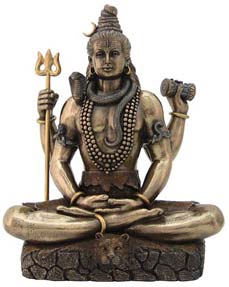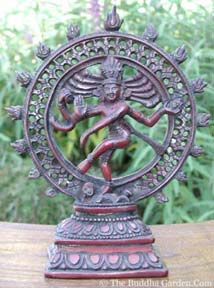Shiva The God Of Destruction
Shiva is one of the most widely known and revered Hindu gods. Shiva is oftentimes worshipped as one member of the Holy Trinity of Hinduism, with the gods Brahma (the Creator) and Vishnu (the Protector) existence the other deities. While Shiva doesn�t testify up until late in the history of Hinduism, it is believed that He evolved from the before Hindu God Rudra, mentioned in the Rig Veda, and is normally associated with destruction. All the same, Shiva is besides associated with reincarnation, since in Hinduism death is believed to be a necessary footstep for rebirth.
Just Shiva has different aspects that appear at dissimilar times. Shiva is frequently depicted as the destroyer, and will announced equally a naked ascetic accompanied past demons, encircled with serpents and necklaces of skulls. Sometimes Shiva wanders into crematoriums, smears his body with ash and dances in the light of the funeral pyres, reminding all well-nigh the transitory nature of cloth things.
Another mutual class is that of Dancing Shiva Nataraja. This is Shiva engaged in a cosmic dance. Information technology is believed that the free energy from this dance sustains the cosmos, and when Shiva is finished with this dance, this universe volition cease and a new one volition begin. Sometimes the creative force of Shiva is depicted, and in item Shiva is represented by a phallus, known as the lingam. Other times Shiva is seen in statues equally the god of meditation and asceticism. He volition be depicted sitting cross-legged with his eyes half-closed.

Shiva MeditationThe God of Destruction Is also The God Of Yoga Cost: $83.95
Shiva�southward Family unit Ties
One of the many complexities nigh the God Shiva is his role as a head of household. According to different sources, he has several wives, with the major Hindu Goddess Parvati being one of them, and the lesser Hindu Goddess Ganga beingness some other. While the bulk of stories detailing the Shiva�s romantic side bargain primarily with his relationship with Parvati, he is as well respected for his willingness to throw himself at the anxiety of some other consort, the Goddess Kali in order to stop her blood thirsty rampage of destruction. Equally for his offspring, Ane of his sons, Ganesh, is the elephant headed god of success who is recognized and worshipped nearly universally throughout Hindu India. Another son, Skanda, is worshipped primarily in Southern Republic of india.
Shiva�s Symbols and Iconography
Snakes are frequently associated with Shiva, since they are able to regenerate their skins by discarding their sometime ones. Also, in southern India, deer are associated with Shiva because their antlers re-grow after falling out. Shiva is also associated with the rainy season, equally the monsoon rains transform the ground from dessert into fertile valley. Shiva rides upon his mountain, Nandi the Balderdash, which is also worshipped past some groups as a deity in its own. As Rudra, Shiva is depicted with a Deer. As an ascetic, Lord Shiva may be depicted sitting upon a tiger pelt. Shiva is about commonly depicted with iv artillery.

Resin ShivaIs Indian trip the light fantastic influenced by the poses of the Gods and Goddesses?Price: $34.95
In the Dancing Shiva Nataraja form, the left leg is lifted slightly off the ground, and this ascent upwards represents liberation (as in liberty from zipper, or liberation from samsara). The right leg is slightly bent and tramples upon a demon, representing the conquest over ignorance. A halo surrounds the King Of The Dance, and the flames in the halo represent Angi The God Of Fire.
Another form is of Shiva and Parvati combined into one epitome, where the right side of the statue depicts Shiva, while the left manus side of the statue depicts his espoused Parvati. This is referred to as a Shiva Shakti or a Hari Hara (Day and Night) statue, amid other names.
But Shiva is not always represented in anthropomorphic (human-like) class. 1 of the most common representations is that of a lingam � a rock phallic symbol � that is venerated in temples. This form is said to house the artistic energy of the universe, and so during pooja (worship), milk is poured over the lingam to absurd it. Sometimes the lingam will accept an image of Shiva�s face up carved into the stone besides, and in at to the lowest degree one example, in that location is a tall standing lingam with a representation of the entire body of Shiva carved into information technology.
The Weapons of Shiva
Many Hindu Gods and Goddesses carry weapons, and Shiva is often depicted carrying a trident, every bit the three tips of this weapon correspond the creation, protection (or sustaining), and destruction of the universe. Because he is so closely associated with ascetics, who renounce the world in search of spiritual enlightenment, Shiva is oftentimes depicted carrying an ax, which is to symbolize the severing of ties to the cloth world. But undoubtedly Shiva�s almost powerful weapon is his Third Eye in the middle of his forehead, which, when opened fully, tin incinerate man, demon, or god.
See Also:
Mahashivaratri Festival
The Dandy Dark of Shiva is a celebration of this Hindu God.
Information technology is believed past devotees of Sri Shiva that Sri Ganga, the Goddess of the sacred Ganges River, resided in the heavens with the other Hindu deities. However, she ran afoul of the Gods there (there are several different explanations why), and she was banished from Sky. She threatened to crash to the earth and flood the whole planet, so the Gods implored Lord Shiva to practise something near the impending doom.
Lord Shiva caught the falling Goddess Ganges in his matted hair to break her autumn, where she resides today, and she is considered a consort of Lord Shiva.
This may be role of the reason that Lord Shiva is considered the God of Rebirth, since the Ganges River floods in a yearly wheel (coinciding with the monsoon seasons) and it is this flooding that helps bring h2o to the crops that lie in the inundation obviously. In essence, Shiva, via his espoused Ganga, "rejuvenates" the land by bringing much needed water to crops.
This is similar to how the Crescent Moon became associated with Shiva, since the moon appears and disappears (waxes and wanes) cyclically. To the ancients, they believed the moon was "reborn" every lunar month.
Shiva The God Of Destruction,
Source: https://www.thebuddhagarden.com/shiva-hindu-god-destruction.html
Posted by: perrybeephe1978.blogspot.com


0 Response to "Shiva The God Of Destruction"
Post a Comment